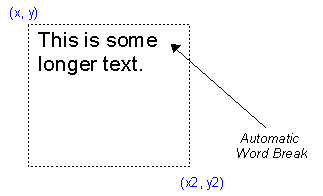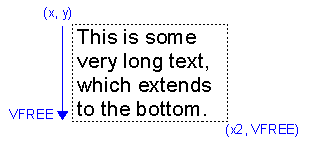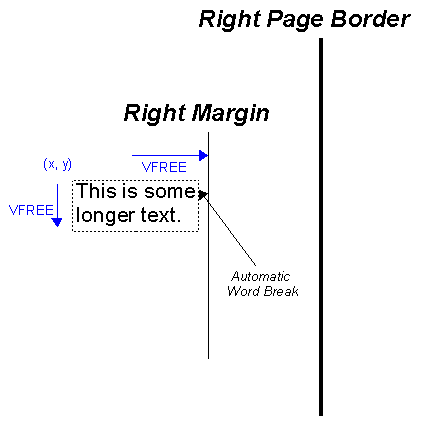|
<< Click to Display Table of Contents >> Dynamic Text |
  
|
|
<< Click to Display Table of Contents >> Dynamic Text |
  
|
In the following (left, top, right bottom) is written as (x, y, x2, y2).
For Text and Rich Text, VPE computes automatically word-breaks according to the setting of the object's right coordinate (x2). If text reaches the right coordinate, it is broken at the next possible word boundary to the next line, and text output is continued at the left coordinate (x) of the object until all text has been drawn, or the bottom coordinate of the object is reached.

| Fig. 1: | (x, y) and (x2, y2) are fixed coordinates. A word-break occurs at the object’s right boundary (x2). |
If the bottom coordinate is not dynamic (i.e. not VFREE) and there is not enough room to output all text, remaining text will be clipped.

| Fig. 2: | (x, y) and (x2, y2) are fixed coordinates. A word-break occurs at x2. The bottom coordinate is not large enough, so remaining text is clipped. |
If the right coordinate is dynamic, text will extend to the right.
NOTE: for Rich Text (RTF) x2 can not be set dynamic.

| Fig. 3: | (x, y) and y2 are fixed coordinates. x2 is dynamic, the text extends to the right. The right coordinate is computed accordingly. |
In the following example the right and bottom coordinates are dynamic, watch the difference of the bottom coordinate in contrast to the previous example.

| Fig. 4: | (x, y) are fixed coordinates. (x2, y2) are dynamic, the text extends to the right. The right and bottom coordinates are computed accordingly. |
If the bottom coordinate is dynamic (i.e. it is VFREE), the object will grow downwards until all text has been output. If the bottom margin is reached and there is still text remaining which needs to be drawn, VPE can break the text automatically to the next page, depending on the settings of the property AutoBreakMode (see “Automatic Text Break”).

| Fig. 5: | (x, y) and x2 are fixed coordinates. y2 is dynamic, the text extends to the bottom. The bottom coordinate is computed accordingly. |
If you use VFREE for the right coordinate (x2) of a text object, the right page margin (see the next chapter "Page Margins"), will be used as the maximum possible coordinate to which the dynamic coordinate may extend. If the right border of the object reaches the right margin, a word-break will be computed and text is continued on the next line at the left coordinate (x) of the object.
NOTE: If text is positioned to the right of the right margin, the right page border has the same effect as the right margin.

| Fig. 6: | (x, y) are fixed coordinates. (x2, y2) are dynamic, the text extends to the right until the right margin is reached. The right and bottom coordinates are computed accordingly. |